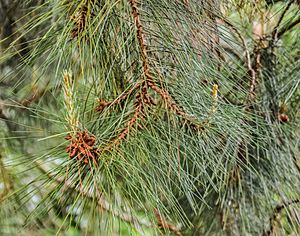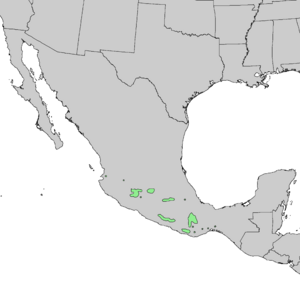Pinus lawsonii facts for kids
Quick facts for kids Pinus lawsonii |
|
|---|---|
 |
|
| Conservation status | |
| Scientific classification | |
 |
|
| Natural range of Pinus lawsonii |
Pinus lawsonii, also known as Lawson's pine, is a special type of conifer tree. Conifers are trees that usually have needles instead of leaves and produce cones. This particular pine tree belongs to the Pinaceae family, which includes many well-known pines, spruces, and firs. Lawson's pine is quite unique because it is found only in Mexico.
Contents
Lawson's Pine: A Mexican Treasure
Lawson's pine is a beautiful tree native to the mountains of Mexico. It grows in forests alongside other pine and oak trees. These areas often have a mild climate with good rainfall. The tree thrives in places where it can get plenty of sunlight. It is an important part of the forest ecosystem in its native home.
Where Does It Grow?
Lawson's pine is found in several states in Mexico. These include Oaxaca, Guerrero, and Michoacán. It typically grows at medium to high elevations. This means you would find it on mountain slopes. The specific areas where it lives are often rugged and hilly. Its natural habitat helps it to grow strong and tall.
What Does It Look Like?
Lawson's pine can grow to be a medium to large-sized tree. It can reach heights of up to 30 meters (about 98 feet). The trunk is usually straight and strong. Its bark is rough and scaly, often reddish-brown.
Needles and Cones
The needles of Lawson's pine are long and slender. They grow in bundles of three or five. These needles are a fresh green color. The cones are also quite interesting. They are usually egg-shaped and brown. These cones protect the seeds of the tree. When the seeds are ready, the cones open up.
How Do Pine Trees Reproduce?
Like all conifers, Lawson's pine reproduces using cones. Pine trees have both male and female cones. The male cones are small and produce pollen. The female cones are larger and contain ovules.
The Life Cycle
Wind carries pollen from the male cones to the female cones. This process is called pollination. After pollination, the seeds begin to develop inside the female cones. It can take a year or two for the seeds to fully mature. Once mature, the cones open up. The seeds then fall out and are carried by wind or animals. If a seed lands in a good spot, it can grow into a new pine tree. This cycle helps the forest to continue growing.
Why Are Pines Important?
Pine trees, including Lawson's pine, play a vital role in their environment. They help to prevent soil erosion, especially on mountain slopes. Their roots hold the soil in place. They also provide homes and food for many animals. Birds and squirrels often eat the seeds from pine cones.
Conservation Status
The good news is that Lawson's pine is currently listed as "Least Concern." This means it is not in immediate danger of extinction. However, like many trees, it can be affected by deforestation. Protecting its natural habitat is important for its future. People also use pine wood for various purposes. This includes building and making furniture. Sustainable forestry practices help ensure these trees can continue to thrive.
See also
In Spanish: Pino ortigillo para niños


